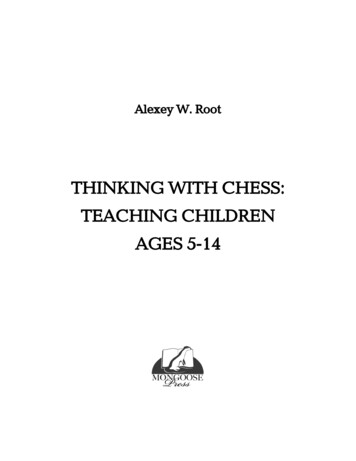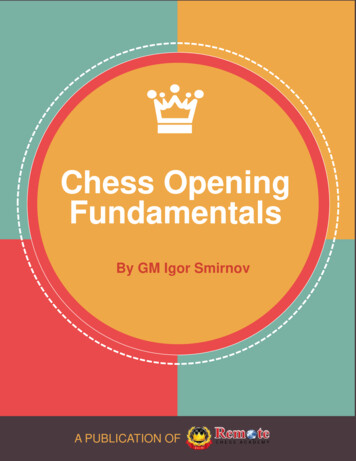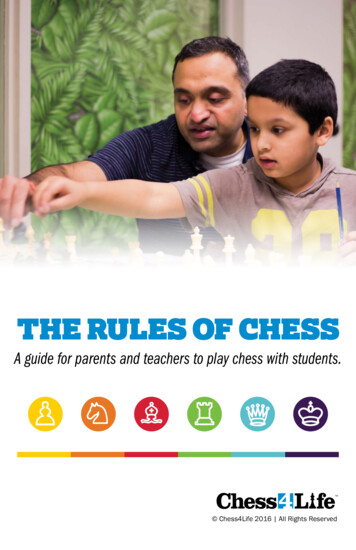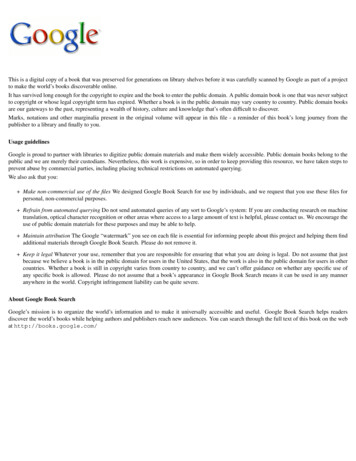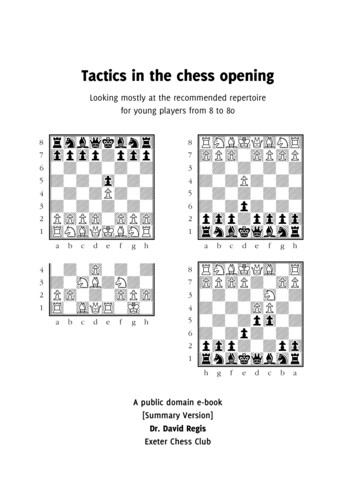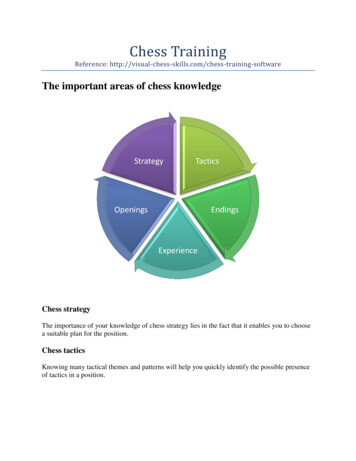
Transcription
Chess TrainingReference: wareThe important areas of chess hess strategyThe importance of your knowledge of chess strategy lies in the fact that it enables you to choosea suitable plan for the position.Chess tacticsKnowing many tactical themes and patterns will help you quickly identify the possible presenceof tactics in a position.
Chess OpeningsIn the opening (the first 13 moves or so) pieces and pawns are mobilized for attack and defense.The four primary opening goals are:1.2.3.4.Control the CenterDevelop all the pieces, especially the minor piecesSafeguard the KingHinder your opponent whenever possibleKnowing your openings will help you to successfully achieve the opening goals and be preparedand ready for the middlegame.Chess EndingsThe goals in the endgame are:1. To checkmate the opponent’s King2. To promote a pawn to help achieve goal 1.while preventing your opponent from achieving the same goals.Knowing a variety of chess ending themes and patterns will help you to press home the win in asuperior position and give you a better chance to draw in an inferior position.Chess experienceThe strength of your chess play depends largely on your decision making process. Your decisionmaking process is refined and improved over time through gaining experience by:1. playing chess2. studying chess-related materialExperience is a valuable source of chess knowledge that draws from your memory of gamespreviously played either by yourself or by other strong players. Analyzing grandmaster gamescritically allows you to tap into the experience of the great players Analysing your own gamesallows you to determine any weaknesses in your play and allows you to take steps to correctthem.The role of chess visualizationYour knowledge of chess plays a significant role determining how well you can play. However,your knowledge relies substantially on your ability to calculate. Improving your chessvisualization skill can help to improve your calculation effectiveness.
Chess strategy trainingChess strategy refers to the plan you devise for the position. How often in your chess games doyou reach the point where you feel: “Now I am not sure what I should do next”? The plan youfinally decide on, will reflect your understanding of the nature of the position. Thus the first stepin deciding on your chess strategy is to evaluate the position to the best of your chess knowledge.The image illustrates the most important aspects that should be considered in order to evaluatethe intricacies of the position on which you will base your chess strategy:King yChess strategy: King safetyAn unsafe king is generally the greatest weakness a position can have.Typical elements that weakens the king’s safety:1.2.3.4.Any weakness or absence in the pawn shield in front of the king.Fewer defenders than opposing attackers in the area near the king.Lack of centre control gives attacking pieces easier access towards the unsafe king.A king that delayed castling for too long (unless the centre is blocked).Tip: Since the safety of the king is so important, it is one of the main principles of chess strategyduring the opening stage of the game. The other important principles of chess strategy during theopening are effective development of the pieces and your share of control in the centre.
Chess strategy: Pawn structure qualityThe quality of the pawn structure can usually be judged by the following factors:1.2.3.4.How it supports and affects the mobility of the pieces,how dynamic it is (how easily it can change),the presence of weaknesses like some isolated pawns andthe squares which have been permanently weakened by pawn moves.If possible, weaknesses in the pawn structure should be fixed before they become permanent.Tip: Weaknesses in the pawn structure is only relevant if the opponent can attack them. Oftenyou can have some form of compensation for a weakness in the pawn-structure – which mightwell outweigh the disadvantages thereof.Chess strategy: Piece qualityPiece quality refers to the quality of the role that a piece plays in the position as well as how wellit co-ordinates with the other pieces. Some determinants of the quality of the role the piece plays,is:1. Mobility – The amount of squares available for the piece to move to gives an indicationof its mobility. The more squares it can go to, and the number of targets it strikes, thehigher the quality of the piece.2. Flexibility – How easily can it change its role? Pieces near the centre are usually moreflexible than pieces on the flanks and therefore have a higher quality in this regard.3. Stability – How easy is it for the opponent to exchange or remove a piece from itssquare? Pieces that can’t be easily removed have a higher stability value.4. Importance of the task – Ideally a piece would perform both an attacking as well asdefending role simultaneously. In some cases a piece would perform a very importantdefensive task, freeing other pieces for more aggressive roles.Piece quality refers to how well a piece is performing compared to its potential, but piecequantity refers to the number of pieces on the board. Having a material quantity advantage is themost important advantage you can achieve – if the opponent does not have sufficientcompensation for the material deficit. While it is often hard to obtain a material advantageagainst stronger players, achieving superiority in the quality of your piece placements can giveyou something to work with.Chess strategy: Square control (Space)Tip: Space advantage refers to one side controlling more squares of the board than the otherside. Since this extra space will naturally increase the mobility and flexibility of your pieces –their quality will increase. It follows that the space advantage is one of the most important chessstrategic advantages you should play for.
Chess strategy: Square control (Center)The importance of the control of central squares lies predominantly in the fact that it enhancesthe quality of your pieces – enabling them to fulfill more diverse roles and increasing theirmobility. This ultimately means that your position is more flexible when you control the centreand it will be easier to create or take advantage of weaknesses in the opponent’s position.The situation in the centre is often the greatest determinant of the chess strategy you shouldfollow in a game. The typical strategies follow logically from your observation of the situation inthe centre, for example:1. Closed centre: When the centre is blocked and cannot open easily, you have more timeto organize your pieces. The play will occur on the flanks of the board. Your chessstrategy would then be to optimize the placement of your pieces and prepare to occupyany file that may open up. In blocked positions, control of an open file is often a usefuladvantage.2. Open centre: An open centre demands that your chess strategy is to have very activepieces. In a situation where the centre is open but your pieces are placed passively, youwill lose quickly. Minor weaknesses are often not so important in open positions, since awell conducted attack would decide the outcome of the game before the weakness can beexploited by the opponent. A position with an isolated centre pawn is one example wherethe player with the “weak” isolated pawn gains compensation in the form of open linesfor his/her pieces. Many pawn sacrifices are also based on this same strategic principle.3. Dynamic centre: This simply means the situation in the centre is not yet clarified. In thiscase, your chess strategy should firstly be to clarify the situation in the centre. Takingoffensive actions on either of the flanks whilst the centre situation is not yet clarified isoften a mistake. If you attack on one of the flanks before the centre situation is clarified, awell-timed counterattack in the centre could well prove your pieces to be offside andunable to sufficiently defend the weaknesses you created in your own position.4. Mobile centre: A mobile center is where you have a pawn chain containing at least twounited pawns and your opponent has a maximum of one pawn in the center. In this case,your chess strategy should be to advance your center pawns and create at least onepassed pawn in the centre.5. Fixed centre: In this case the pawn position in the center is held in a closely locked gripoften consisting of a pawn on each side directly opposing each other. The attacking sidestations his pieces in and around the center and occupies the central field to the greatestpossible extent. The defending side seeks to drive the enemy pieces away from thecentral field or to exchange them off.Tip: Memorizing annotated grandmaster games is a great way to improve your understanding ofchess strategy principles.
InitiativeTip: Initiative refers to the ability to continually make threats against the opposing position. Thisimplies that the opponent has to respond to the threats and cannot find time to make theimprovements he/she would like to make to their position. The initiative could be only atemporary advantage and the player with the initiative must play very accurately in order tomake the most of it.
Chess tactics trainingEffective chess tactics training consists of more than simply solving 100’s of chess tacticspuzzles. The image suggests the main focus areas of an effective chess tactics training tionVisualization skillsThe ability to visualize an imaginary position that would result if certain moves were to be made,plays a vital role in the effectiveness with which you will be able to spot tactical opportunities inyour games. Training your chess visualization skills should be a priority in your chess tacticstraining schedule, particularly if you have not focused on this skill before.Sources for chess visualization training:1. The Chess Visualization Training site has several good exercises to train yourvisualization ability.2. The Chess Trainer Software is a wonderful java program that provides many differentexercises to train your visualization skills.
Tactical themes and patternsWhen you are training chess tactics and chess combinations by solving numerous chess puzzles,seek to understand the elements in the chess problems which makes the combination possible.Solving chess problems this way will help you hone your “tactical awareness” in the sense thatyou will instinctively search for chess tactics motifs and themes in positions where you noticethe presence of the typical elements of chess tactics.Tactical motifs There are four major tactical motifs:1. Geometrical (points and lines)2. Functional (duty, job, or role)3. Restrictive (inhibits movement), and4. Promotional (promoting a t least one of the following factors must be present for a combination to work:1. Undefended pieces,2. Inadequately defended pieces3. An exposed (unsafe) king, and4. A majority of force or material in a certain part of the board.The most important tactical themes are:1. Pins,2. Double Attacks, and
3. Back Rank Mates.When looking for tactics always watch out for all1. Checks2. Captures, and3. Queen Checksfor both you and your opponentTactical training cyclesHot tip: Wading through 100’s or 1000’s of chess tactics puzzles will surely improve yourtactical skills, but consider this method: Focus on a smaller amount of tactic sets (i.e. a set of 20selected tactics) and repeat them daily (or weekly, however you prefer) until you can literally dothem all with your eyes closed. Training chess tactics this way helps you to identify themes andpatterns much faster.Chess calculationChess calculation consists of selecting candidate moves, determining where they would lead toand assessing the outcome of the possible variations. This step starts with deciding whether ornot the position actually requires you to calculate variations! In many positions the correctmove(s) can be identified by simply considering the strategic aspects of the position. It remains agood idea to do a tactical check and a blunder check for a move in a position where you regard itnot necessary to calculate variations. The need to carefully calculate a variation is oftennot necessary in positions where:1. The pawn structures are fixed in a closed position, or2. When it is obvious that a certain move is best or required.Here are some suggestions on how to train your chess calculation ability:3. Analyze complicated positions from annotated grandmaster games as deeply as you can.Compare your findings with the analysis of the grandmaster (or a strong chess engine).4. Training chess tactics will also benefit the development of your calculation skill.5. Invest time to train your visualization skill – it will have a tremendous impact on yourcalculation ability.Sources for chess tactics training:6. The Step Method Daily Puzzles are wonderful for gaining tactical ideas and improvingone’s tactical calculation.7. Chesstempo.com is a great website for chess tactics that come from actual games andthey also have a page which illustrates typical chess tactics motives that commonlyappear in chess games.
8. www.ideachess.com has a great election of 1, 2, 3, and 4 move checkmates in addition toeasy, moderate and difficult tactics.9. CT ART (Chess tactics art) is a popular program which consists of more than 2200 chesstactics sorted according to themes. This provides a good way to train chess tacticsaccording to their themes.Chess Opening trainingOpening training consists of more than simply memorizing lines and variations. The main focusof an effective chess opening training program is to:1. Learn the ideas and themes in the opening2. Play the opening in blitz games to quickly gain experience with a wide variety ofpositions3. Learn the standard traps for bo
Calculation Training Cycles Visualization . Tactical themes and patterns When you are training chess tactics and chess combinations by solving numerous chess puzzles, seek to understand the elements in the chess problems which makes the combination possible. Solving chess problems this way will help you hone your “tactical awareness” in the sense that you will instinctively search for .
